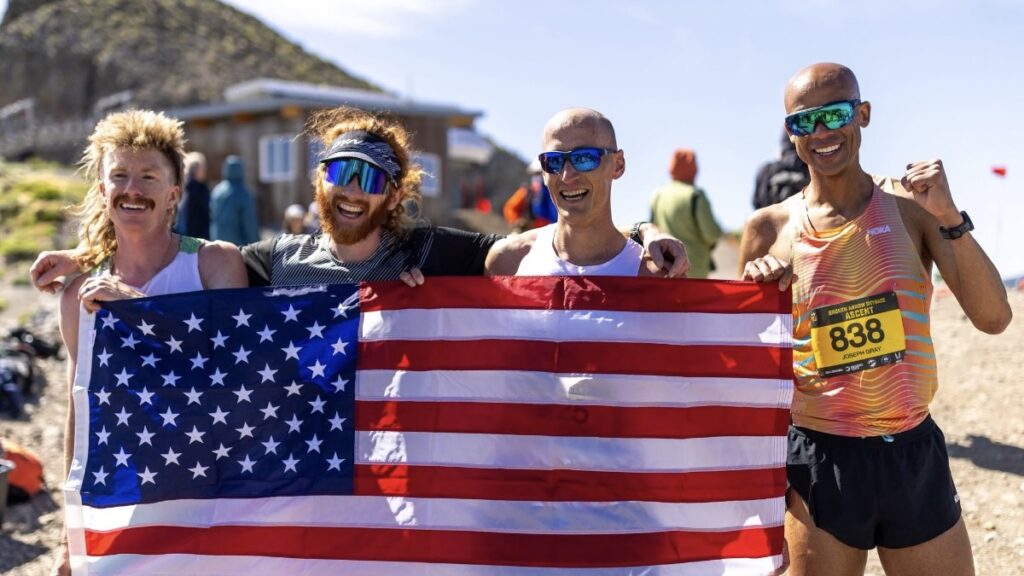In recent racing news, the 2025 Broken Arrow Skyrace Ascent showcased a dynamic and competitive atmosphere, particularly pertinent to experienced trail and ultrarunners eyeing performance in mountain races. With its challenging course and notable athlete participation, the event highlighted essential aspects of training, pacing strategies, and race tactics that can resonate with experienced runners looking to refine their approach.
The race, shortened due to expected gale force winds, covered just 2.15 miles with an ascent of 1,800 feet. Although the distance was reduced, the competition remained fierce. Christian Allen and Anna Gibson emerged as the men’s and women’s champions, respectively, for the uphill race, securing spots on the U.S. team for the upcoming World Mountain Running Championships. Allen completed the course in an impressive 23:49, showcasing not only competitive speed but also an adept understanding of race dynamics. His post-race comments hinted at critical pacing decisions; rather than detonating early, he strategically conserved energy until the moment it mattered, illustrating a tactical approach often overlooked in shorter races.
Allen’s performance four months after his 2:10 marathon time at Houston reflects the versatility required in mountain racing—an ability to switch from longer flat races to technical ascents. His victory also underscores the importance of training specificity in adapting to varied terrains, emphasizing that preparation should be multifaceted, incorporating both speed work and endurance in mountainous settings. Following closely in the men’s race, veteran Joseph Gray seized second place with a time of 24:12, illustrating a valuable lesson in maintaining consistency across multiple races. Notably, he balanced this effort with recent contests, enhancing the discussion around optimal frequency in race participation without succumbing to fatigue.
The competitive field was further characterized by rising talents like Cam Smith and Tyler McCandless, who not only aimed for podium positions but successfully qualified for dual events at the championships. This aspect of dual qualification is a critical update for runners prepping for prestigious ultramarathons like UTMB, as it emphasizes the importance of multi-discipline capabilities—training effectively for uphill as well as mixed elevation races.
Switching focus to the women’s race, Anna Gibson’s performance exemplified dominance and strategic execution. With a race time of 27:32, her ability to lead by a significant margin demonstrates the importance of psychological fortitude and tactical foresight. Gibson’s nearly minute lead at the halfway point affirms the benefits of establishing an early aggressive pace when conditions allow. Such insights are crucial for experienced runners who must weigh the risks of pushing early against the potential rewards of securing control over the race.
Gibson’s competitors, particularly second-place finisher Joyce Njeru, a previous champion, added nuanced implications about adaptability in performance. Njeru’s time of 29:06 suggests an ongoing evolution in form, reminding seasoned runners that the path of development is rarely linear. Such dynamics can inform training regimens, encouraging athletes to focus on recovery and long-term progression rather than immediate results, especially when transitioning from previous race failures to successes.
The presence of elite international athletes also adds depth to the competitive landscape. The inclusion of runners like Jade Belzberg from Canada further reflects a growing trend in securing top talent from around the globe for US events, allowing for diverse race strategies and showcasing varying strengths in climbing technique and endurance. For seasoned trail runners, this serves as a strategic reminder that competition now extends beyond national boundaries, necessitating broader research into competitors’ backgrounds, prior performances, and even gear choices.
Speaking of gear, the event’s dynamic elevation changes brought to light the critical nature of choosing the right equipment. Runners who utilized light yet reliable trail shoes designed for steep ascents likely had an advantage over others who might have relied on less specialized footwear. As an experienced ultrarunner, such nuances will dictate training sessions where gear trials are integrated, ensuring that footwear and clothing choices can withstand both dry and adverse weather conditions typically encountered in mountain races.
Communication, teamwork, and pacing for those not in contention for a podium finish also deserve attention. For runners focusing on personal bests rather than race wins, developing a strong acumen for timing one’s efforts in relation to competitors can be crucial, particularly when racing in a pack. Observations from the race indicate how maintaining close proximity to stronger athletes without exhausting oneself can yield benefits, as demonstrated by Gray, Smith, and other runners who skillfully navigated through the crux of the race’s tougher sections.
In preparation for future events, as runners assess their own strategies and training regimens, the 2025 Broken Arrow Ascent exemplifies the importance of adaptability and comprehensive race planning. It highlights the dual necessity of building a robust physical foundation and developing strategic insights that can be applied to various race scenarios. The prevailing takeaway lies in understanding individual limits and the tactical application of energy throughout a race—ensuring that when it matters most, experienced runners can seize opportunities to outperform competitors precisely at the right moments.
Ultimately, integrating these insights into regular training routines can foster an athlete’s growth not just in tactical execution but also in versatile race performance.
